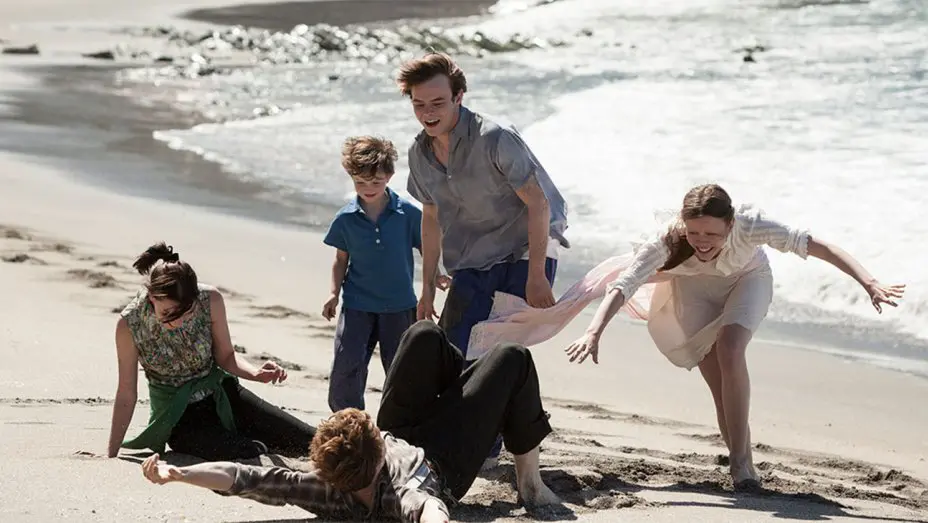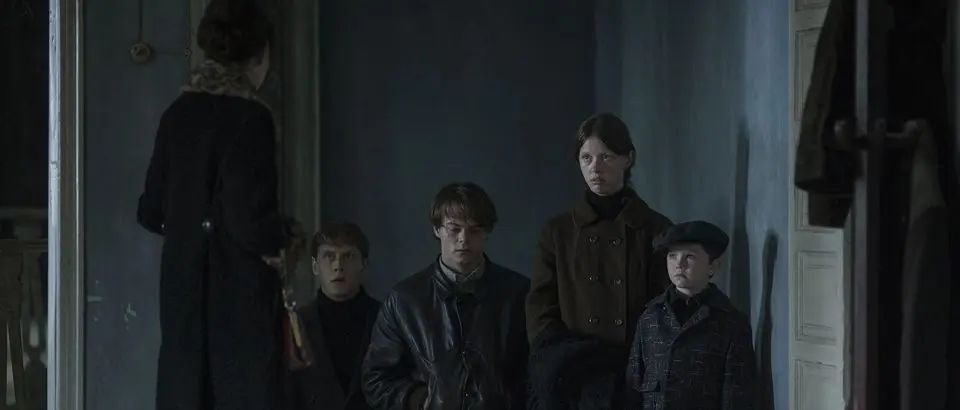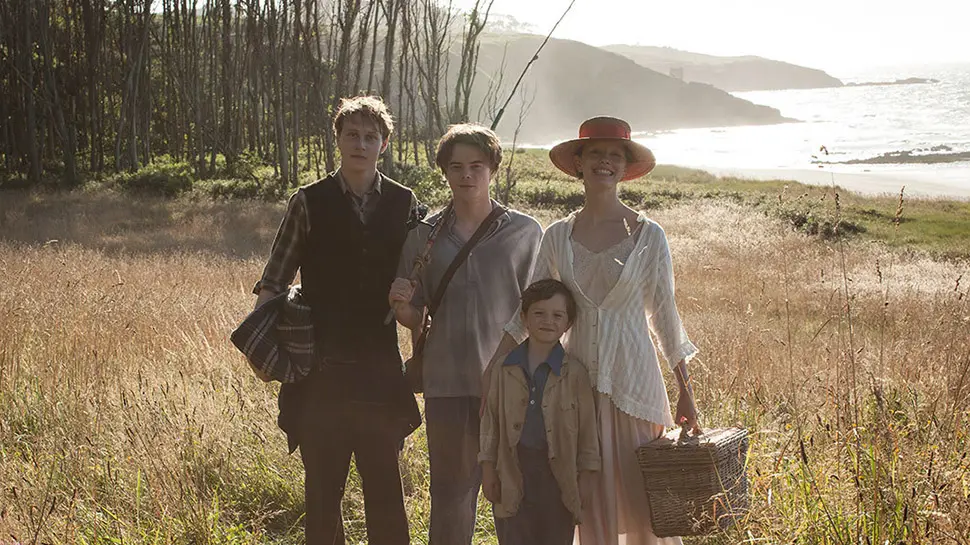Summary
In Marrowbone (or The Secret of Marrowbone) four siblings move to America with their mother in sunny 1969, make a new friend, and live in a creaky old house. Go watch it before you read anything else.
There is a lot that is great about Marrowbone (or The Secret of Marrowbone, if you’re in the UK or Spain). Really, a lot. I was able to see some flaws when I watched it last night, but they seemed so small and the film surprised me so much I really had to focus to see its various qualities in perspective. So, I slept on it, and here’s what I’ve got.
The plot of Marrowbone is a fairly simple one, or at least it appears that way at first: a family moves home (from England to America, couldn’t say what part) because of some bad history with the husband/father (Tom Fisher) and settle in the big old house the mother, Rose Marrowbone (Nicola Harrison), grew up in. They are happy to explore and settle there and it’s clear they feel safe and able to put the past behind them. Unfortunately, Rose was not a well woman and died with her loving children around her, but before she could legally secure ownership of the house. The siblings keep her passing secret, as they will be at risk of separation otherwise, and as they are always on their guard in case their father discovers them, looking after the house by themselves clearly becomes more difficult.
The Secret of Marrowbone starts off full of sunshine and smiles, with the family clearly feeling the relief of escape from their past. It’s almost too good to be true. Many ghost stories start like that (haven’t I mentioned it’s a ghost story?); and many period films especially, I think. In this one, the smiles became difficult to maintain, but the sunshine carried on. It creates a lovely contrast with the house itself, which steadily falls into disrepair: things may be difficult, but keep going; there is hope. There is one person who does keep smiling: the family’s new friend Allie (Anya Taylor-Joy), who is the only real link they have to the nearby town, while they try to maintain discretion.

The film is written and directed by Sergio G. Sánchez (and it was filmed in his home country, Spain), best known as a writer of period horror The Orphanage, though this is his first feature as a director. But the same careful laying out of background details only when needed is reflected in the pacing: Sánchez can indeed direct. There are quite a number of familiar film tropes in The Secret of Marrowbone, mind you (both for period films and haunted house films); but by and large they fit with the period the story is set in, and they serve to make the viewer feel comfortable with where the story is going, and thus not quite anticipate where it actually goes.
The production and cinematography are – please excuse me – sublime. I’ve been to Spain only once before, and the area I visited was nowhere near as green as it is in the filming locations of The Secret of Marrowbone. I want to go and explore the rest now! The interiors are carefully established too, with the period detail as good as in Del Toro films such as The Devil’s Backbone. It isn’t simply a creaky old house; there are special areas which have meaning to the kids and to the story, such as the mother’s room, the attic and the “fortress” which are all designed with perfect care, so the viewer feels like it’s a real home with real feelings attached to it.
A bit more about the characters, which are largely made up of the four siblings (the parents have such small parts) and two supporting characters from the local town. The oldest brother is Jack (George MacKay) and he is obliged to be a surrogate parent, despite being less mature than he comes across; at times, the pressure clearly shows. The next oldest, Billy (Charlie Heaton, letting off some of the steam he built up in Stranger Things) does not find being hidden away comes easy to him, so he takes any chance to find a practical outlet for his tension. Jane (Mia Goth) is just a little younger, but clearly very affected – slightly OCD perhaps? – by the trauma left in England, and perfectly suited to taking on a maternal role towards the youngest. He is five-year-old Sam (Matthew Stagg), sensitive to what goes on around him, and itching to be bigger; both natural when surrounded by kids more than three times his age. I’ve already mentioned Allie, who becomes a sweet love-interest for Jack, much to the pique of the last person I want to mention: Tom (Kyle Soller), the ambitious local lawyer. He is important to the family as he is involved with their home ownership issues; and he is important to the film as he provides a Scooby-Doo-like real baddie that contrasts with the ghost the siblings are always on the lookout for.
The characters may seem somewhat twee or clichéed for a period drama at first, but the story is so well crafted and the characters well written that these personalities turn out to be right for them. Trust the writer. The acting throughout – especially the siblings – is superb: the writing and the acting combined makes the characters very believable. Jack’s character particularly is much more complex than it first appears; MacKay pulls it off impressively well. Matthew Stagg – the youngest – could be the next Jacob Tremblay.

So what is wrong with Marrowbone, then? Well, a couple of things. It’s clearly a period film, but what period is unclear. The clothing and manners could belong in the 1950s or early sixties in rural America, but Sánchez felt the need to spell out that it was 1969 by showing a news clip (on a rare TV) of the moon landing. Some aspects of the story are over-explained, like zooming on the word “library” while entering what is very obviously a library, and lots of verbal narration, whereas other aspects, like the time and place, are kept vague. The exposition can be a little annoying, but I think it serves to ensure the film is accessible to a wide range of people; like The Others, this is not a visually upsetting ghost story (or at least, not much), and could suit a teen audience, so why not help them with putting pieces together. And it doesn’t matter that many components of the story are familiar: the way they are put together and taken apart works very well for The Secret of Marrowbone.
Some have described this film as a gothic horror (though with extra daylight), but I can’t quite agree with that myself: “gothic” tends to imply at least a little melodrama, but Marrowbone manages to avoid that. By the end of the film, it’s a story that Shirley Jackson might have been proud of. Marrowbone is about trauma; about the way the past may be behind us, but it will always still exist and always leave a taste. It’s about family – of course – and how the connections within a family can be stifling or enabling or anything in between.
I enjoyed it a great deal, especially the way layers came away gradually – and skillfully – to show more depth to the people and the story. I especially enjoyed the contrast of dark themes with bright daylight; somehow, that gave it an added relatable atmosphere. I hope many more people enjoy it too.




